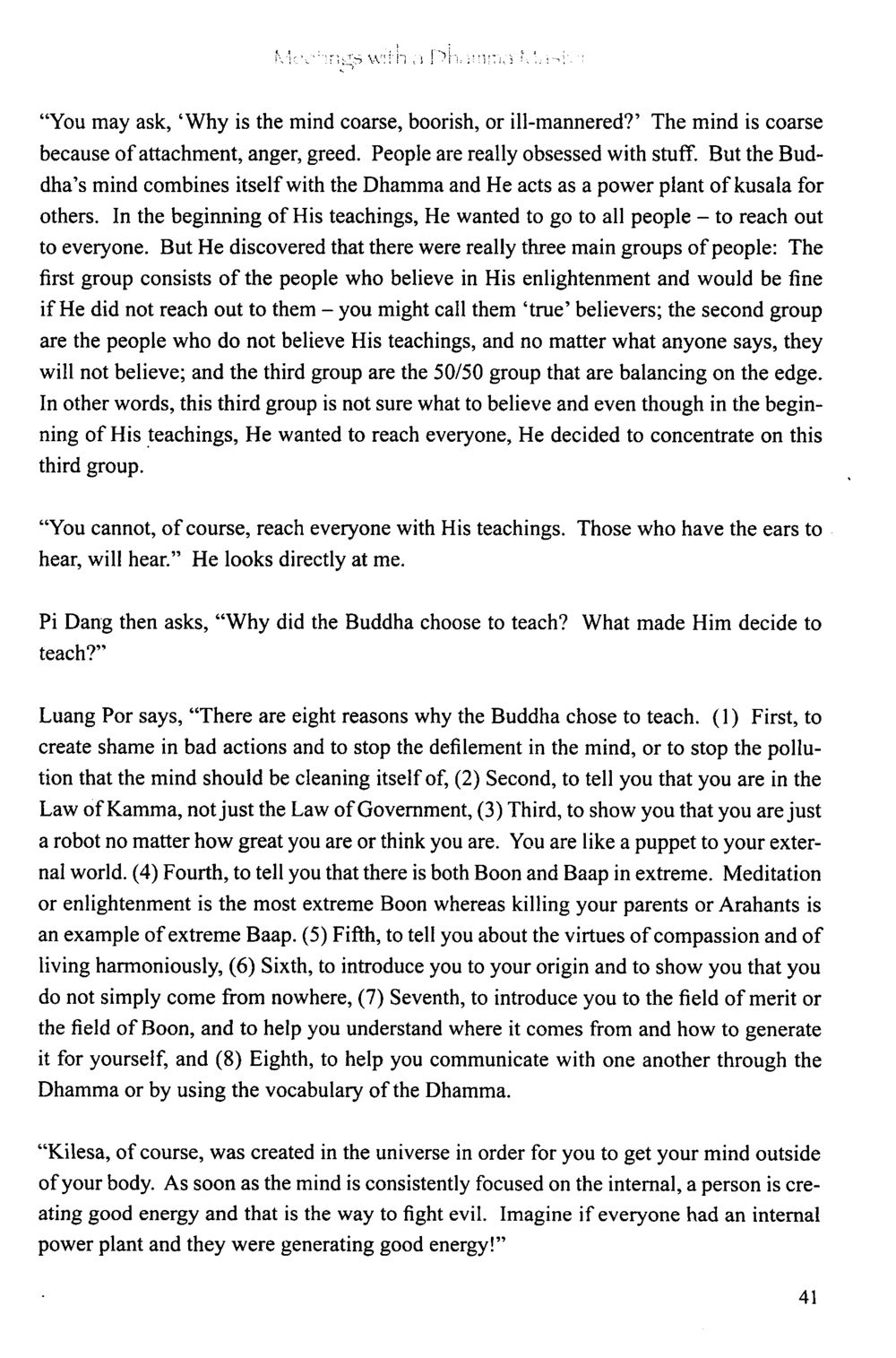Understanding the Buddha's Teachings : หน้า 46/164
The Meeting with a Dhamma Master : หน้า 46/164 Explore the reasons behind the Buddha's decision to teach and his insights on human behavior and the mind.
1 ครั้ง

สรุปเนื้อหา
In his teachings, the Buddha discusses the coarseness of the mind due to attachment, anger, and greed. He identifies three groups of people in response to his teachings: true believers, non-believers, and those unsure of what to believe. The Buddha chose to focus on the latter group, outlining eight reasons for teaching, such as creating shame in bad actions, discussing the Law of Kamma, and illustrating the concepts of compassion and merit. Ultimately, these teachings aim to empower individuals to generate good energy and live harmoniously.
หัวข้อประเด็น
-Buddha's teachings
-Three groups of followers
-Reasons for teaching
-Mind and defilements
-Law of Kamma
-Concepts of compassion
-Field of merit
-Good energy generation
ข้อความต้นฉบับในหน้า
"You're asking, 'Why is the mind coarse, boorish, or ill-mannered?' The mind is coarse because of attachment, anger, greed. People are really obsessed with stuff. But the Buddha's mind combines itself with the Dhamma and He acts as a power plant of kusala for others. In the beginning of His teachings, He wanted to go to all people - to reach out to everyone. But He discovered that there were really three main groups of people: The first group consists of the people who believe in His enlightenment and would be fine if He did not reach out to them - you might call them 'true' believers; the second group are the people who do not believe His teachings, and no matter what anyone says, they will not believe; and the third group are the 50/50 group that are balancing on the edge. In other words, this third group is not sure what to believe and even though in the beginning of His teachings, He wanted to reach everyone, He decided to concentrate on this third group.
'You cannot, of course, reach everyone with His teachings. Those who have the ears to hear, will hear.' He looks directly at me.
Pi Dang then asks, 'Why did the Buddha choose to teach? What made Him decide to teach?'
Luang Por says, 'There are eight reasons why the Buddha chose to teach. (1) First, to create shame in bad actions and to stop the defilement in the mind, or to stop the pollution that the mind should be cleaning itself of, (2) Second, to tell you that you are in the Law of Kamma, not just the Law of Government, (3) Third, to show you that you are just a robot no matter how great you are or think you are. You are like a puppet to your external world. (4) Fourth, to tell you that there is both Boon and Baap in extreme. Meditation or enlightenment is the most extreme Boon whereas killing your parents or Arahants is an example of extreme Baap. (5) Fifth, to tell you about the virtues of compassion and of living harmoniously, (6) Sixth, to introduce you to your origin and to show you that you do not simply come from nowhere, (7) Seventh, to introduce you to the field of merit or the field of Boon, and to help you understand where it comes from and how to generate it for yourself, and (8) Eighth, to help you communicate with one another through the Dhamma or by using the vocabulary of the Dhamma.
'Kilesa, of course, was created in the universe in order for you to get your mind outside of your body. As soon as the mind is consistently focused on the internal, a person is creating good energy and that is the way to fight evil. Imagine if everyone had an internal power plant and they were generating good energy!'"
หน้าหนังสือทั้งหมด

1

2

3

4

5

6

7

8

9

10

11

12

13

14

15

16

17

18

19

20

21

22

23

24

25

26

27

28

29

30

31

32

33

34

35

36

37

38

39

40

41

42

43

44

45

46

47

48

49

50

51

52

53

54

55

56

57

58

59

60

61

62

63

64

65

66

67

68

69

70

71

72

73

74

75

76

77

78

79

80

81

82

83

84

85

86

87

88

89

90

91

92

93

94

95

96

97

98

99

100

101

102

103

104

105

106

107

108

109

110

111

112

113

114

115

116

117

118

119

120

121

122

123

124

125

126

127

128

129

130

131

132

133

134

135

136

137

138

139

140

141

142

143

144

145

146

147

148

149

150

151

152

153

154

155

156

157

158

159

160

161

162

163

164
หนังสือที่เกี่ยวข้อง
Load More
